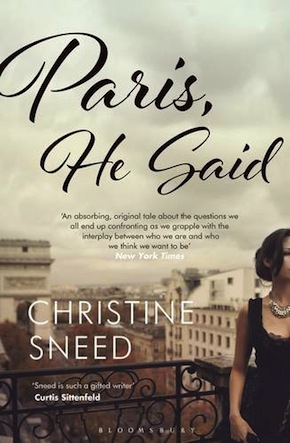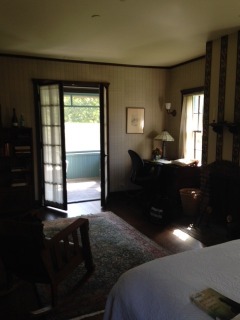A country escape
by Christine Sneed
“A wry, sexy, clever little gem of a novel, Christine Sneed’s latest lights up the streets of Paris with elegance and wit.” Jami Attenberg
Christine Sneed’s latest novel Paris, He Said focuses on a woman in her early 30s who accepts the offer of an older man who invites her to live with him in the French capital and work as an artist. She writes from a luxurious and strings-free creative haven closer to home.
October 2, 2015
Lake Forest, Illinois: I’m at Ragdale, an artists’ colony located about an hour north of Chicago. Along with several other writers, I was invited here to participate in the colony’s Novel Affair, an annual fundraiser that spans an autumn weekend, and this is its eleventh consecutive year. At a cocktail reception and informal buffet dinner earlier tonight, the other featured writers and I met many of Ragdale’s donors and board members, along with creative writing and visual arts teachers from a number of Chicago area high schools and middle schools.
Novelists Bret Lott and Elizabeth Berg, journalist and documentary filmmaker Alex Kotlowitz, actress and playwright Regina Taylor, radio broadcaster Krista Tippett, arts educator Jim Duignan, novelist and biographer Gioia Diliberto and I each spoke for a few minutes about our ties to Ragdale and why it deserves its donors’ ongoing support.
All that aside, whenever I’ve had the opportunity to interact with other writers in a semi-formal setting – whether it’s at a place like Ragdale or at the annual Association of Writers & Writing Programs conference (which over the last few decades has grown from a modest gathering of writers and writing professors to a behemoth literary conference experience that now draws more than twelve thousand attendees each year) – I feel both anxious and a little giddy. How to be a writer in public? Do I talk too much? Do I sound idiotic or at least a little bit interesting?
While the other writers spoke at the cocktail reception, I admired their self-possession and wit. I hadn’t known that Bret Lott, the author of an Oprah Book Club pick, Jewel, once aspired to be a forest ranger. Or that Gioia Diliberto has had in recent years to defend her artistic interests; why, as a past biographer of Jane Addams, for example, is she now writing about fashion icons? (In part, because any subject, if approached from a certain angle, can be both intellectual and political).
 Eventually, it was my turn to speak at the podium for a few minutes. As I addressed the audience, ivy clinging to the walls that surrounded us in the tennis house where the gathering took place, I realized that my beginnings as a writer were serendipitous, Ragdale an essential factor in this incidence of serendipity, as it is the place where I first began to see myself as a writer, not only as a person who occasionally wrote. In the fall of 1994, I signed up for a poetry workshop at Ragdale led by David Wojahn, who was on leave that year from Indiana University where he was a member of the MFA faculty in creative writing.
Eventually, it was my turn to speak at the podium for a few minutes. As I addressed the audience, ivy clinging to the walls that surrounded us in the tennis house where the gathering took place, I realized that my beginnings as a writer were serendipitous, Ragdale an essential factor in this incidence of serendipity, as it is the place where I first began to see myself as a writer, not only as a person who occasionally wrote. In the fall of 1994, I signed up for a poetry workshop at Ragdale led by David Wojahn, who was on leave that year from Indiana University where he was a member of the MFA faculty in creative writing.
Near the end of this six-week poetry workshop, I mentioned to David that I intended to apply to Master of Arts programs in writing. He asked why I wasn’t applying to Master of Fine Arts programs. The simple truth was, I’d never heard of MFA programs. He explained that I should apply to graduate programs that were generative in nature; MFA programs focused on the creation of new work rather than on the analysis of already-published work.
Many writers and visual artists have taken advantage of the time and quiet space that these storied places offer… the books on the bookshelves are a kind of gentle exhortation to be productive, to be hopeful.”
Within the next couple of months, he sent recommendation letters to all the programs I applied to, and it was Indiana University’s program that I decided to enroll in, in the end. They trained their MFA students to teach undergraduate writing classes, paid us to do it, and also waived our tuition.
My life changed very quickly – a Ragdale poetry workshop led to graduate school applications which consequently led to a leave-taking the following August from a subsistence-level secretarial job that I’d had for two years in Chicago after my undergraduate studies concluded.
October 3, 2015
Second day of the Novel Affair. I’ve never had a residency at an artists’ colony (residencies at most artists’ colonies are two to four weeks long), but I applied for one at Ragdale about fifteen years ago. I didn’t make the cut for that year’s cycle, as it turned out, and I didn’t reapply in a subsequent year, although I’ve since written a number of recommendation letters for former students and for friends, and some of them have subsequently spent time at Ragdale (and loved it).
 The campus on which the two Ragdale houses sit is set back far enough from the road to ensure that the sound of passing cars rarely intrudes on the rooms where artists and writers make their homes during their eighteen or twenty-five day stay. Other well-known artists colonies – Yaddo in upstate New York, the MacDowell Colony in New Hampshire, and the Vermont Studio Center, for example, are also located in quiet, pastoral places and follow a similar schedule with their own residency cycles.
The campus on which the two Ragdale houses sit is set back far enough from the road to ensure that the sound of passing cars rarely intrudes on the rooms where artists and writers make their homes during their eighteen or twenty-five day stay. Other well-known artists colonies – Yaddo in upstate New York, the MacDowell Colony in New Hampshire, and the Vermont Studio Center, for example, are also located in quiet, pastoral places and follow a similar schedule with their own residency cycles.
Many writers and visual artists of note have taken advantage of the time and quiet space (and chef-prepared communal meals) that these storied places offer, and it made me wonder why, after my one application to Ragdale fifteen years ago, I haven’t pursued a residency since. One reason, and probably the main reason, is that I don’t have parenting responsibilities, and because of this, it’s relatively easy for me to find enough time most weeks to write at home.
The air at Ragdale, as I imagine it is at other artists’ colonies, is different, however, from the air that immediately assails you once you leave its well-tended environs. I want to go back. I want to write in that quiet room with its screened-in balcony, with its bookcases and their collection of back issues of literary magazines and novels that I’ve been meaning to read (a decommissioned library copy of James Salter’s final novel, All That Is, immediately caught my eye the first time I entered my second-floor room).
One thing I also realized is that at Ragdale, you are not very likely to feel oppressively guilty about neglecting the laundry or yard work or unanswered emails or friendships. You might procrastinate a little in your room after a meal, and you might go for restorative walks on the many acres of prairie just beyond the two houses on the estate, but the Wi-Fi service can be spotty (thank God!), and the books on the bookshelves written by other people are a kind of gentle exhortation to be productive, to be hopeful.
If you have children or a domestic partner, they aren’t waiting for you to make them something to eat. Someone, for a change, is there to cook for you. And that whole time you’re at Ragdale, you do not have to go anywhere – no errands, no drycleaners or grocery store. You only need to go up to your room and write the next sentence…
 Christine Sneed is the author of the novel Little Known Facts, and the story collection Portraits of a Few of the People I’ve Made Cry. She lives in Evanston, Chicago and teaches creative writing for the MFA programs at Northwestern University and the University of Illinois-Urbana-Champaign. Her new novel Paris, He Said is out now in paperback from Bloomsbury. Read more.
Christine Sneed is the author of the novel Little Known Facts, and the story collection Portraits of a Few of the People I’ve Made Cry. She lives in Evanston, Chicago and teaches creative writing for the MFA programs at Northwestern University and the University of Illinois-Urbana-Champaign. Her new novel Paris, He Said is out now in paperback from Bloomsbury. Read more.
christinesneed.com
@ChristineSneed
Author portrait © Adam Tinkham
Pictures of Ragdale by the author

